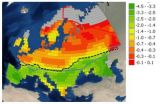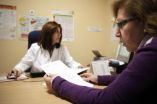The MyCare Card stores personal medical data (e.g. information on existing medical conditions, allergies and medication being taken) and plugs into a laptop's USB port, enabling the data to be accessed in just a few moments.
It is the first device of its type to have been trialled in the UK.
This working prototype has been developed by City University London and Coventry University, with funding from the Engineering and Physical Sciences Research Council (EPSRC).
If the card's owner is taken ill or involved in an accident, paramedics can simply retrieve the card from their pocket or handbag and use the data to gain instant access to their full medical history.
As well as using the data to inform their on-the-spot decisions, paramedics can phone key information ahead to a hospital if necessary.
Initial trials have been successful and the development team now hopes to work with organisations in the healthcare sector to undertake a full-scale pilot programme. If that programme is also completed successfully, the system could be available for patient use within around 3-4 years.
"When dealing with a medical emergency, patients may be unconscious or unable to communicate with paramedics for some other reason," says Professor Panicos Kyriacou of City University, "our device makes potentially life-saving data easily accessible. For example, it's vital to know whether a patient is allergic to latex. If they are, use of latex gloves by a paramedic might be fatal."
The MyCare Card is designed for voluntary use by patients. All data would be held on the card securely so that it could not be accessed if the card were lost.
A patient would keep the card in their possession and add or alter a range of personal information (e.g. on next of kin) on their home PCs. A plug embedded in the card is simply slid out and inserted into a computer; bespoke software then automatically runs from the card. This personal medical data-browsing software was also developed as part of the project.
When treated at a surgery, clinic or hospital, the patient would hand the card over to the medical professionals and the medical information on the card would be updated.
Card updates could also be made at pharmacies when collecting prescription medicines. The patient themselves would be able to view but not alter any of this medical data.
Although patient-held electronic health record cards have been trialled in some parts of the world, the MyCare Card has a number of unique features:
The software underlying the system is written in a portable way using Python programming language, meaning it can be ported easily between different computers and different computer operating systems. The software is very modular and easy to extend, which means it is simple to add new features and database record types. The MyCare system has been developed on an open-source basis, enabling a wide range of people to be involved in reviewing and contributing to the development process.
As part of the project, detailed surveys have been undertaken by Coventry University, led by Professor Andree Woodcock, to assess attitudes to the MyCare Card among health professionals and the public, including those with and without computer skills. These surveys have highlighted the need for a full pilot-scale study to enable all the key issues to be examined in detail (e.g. would GPs be happy to use such a system?).
"The MyCare Card has specifically been designed to be easy to use regardless of your level of computer literacy," says Professor Kyriacou.
INFORMATION:
Notes for Editors
The 3-year 'NHS MyCare' project received total EPSRC funding of just over £260,000.
Access to information stored on the card is secured using user authentication protection similar to online banking. The card prototypes were developed at Coventry University, where the user surveys were also organised; the system's underlying software was developed at City University London.
The code underpinning the software is available from www.myc2.org/download
About EPSRC
EPSRC is the main UK government agency for funding research and training in engineering and the physical sciences, investing more than £850 million a year in a broad range of subjects – from mathematics to materials science, and from information technology to structural engineering. www.epsrc.ac.uk
About Coventry University
Coventry is a forward-looking, modern university with a proud tradition as a provider of high quality education and a focus on multidisciplinary applied research. Its students benefit from state-of-the-art equipment and facilities in all academic disciplines including health, performing arts and design and engineering and computing.
Through its links with leading edge businesses and organizations in the public and voluntary sectors, Coventry University's students are able to access project and placement opportunities to ensure that their employability prospects are enhanced by the time they graduate. The city centre campus is continually developing and evolving, with recent £100 million-plus investment in a new Student Centre and Engineering & Computing building playing a key role in modernising the whole learning experience.
About City University London
City University London is an international University with a reputation for academic excellence and a central London location. It was placed in the top 5% of world universities by Times Higher Education World University Rankings 2010-11.
The University leads London in education, research and enterprise for business and the professions and is ranked 10th in the UK for both the employability of its graduates (by The Times Good University Guide 2011) and graduate starting salaries (by The Sunday Times University Guide 2011).
City is broadly-based with world leading strengths in the arts, including journalism and music; informatics; social sciences; engineering and mathematical sciences; business; law; community and health sciences.
The University attracts over 21,000 students from around 160 countries and academic staff from around 70 countries.
City was founded in 1894 and in 2016 will celebrate its first half century since gaining University title. www.city.ac.uk.
For more information, contact:
Professor Panicos Kyriacou, City University, tel: 020 7040 8131, e-mail: p.kyriacou@city.ac.uk
Images are available from the EPSRC Press Office. Contact tel: 01793 444404, e-mail: pressoffice@epsrc.ac.uk
Suggested captions:
'Card' and 'cardv2' .jpgs: The new MyCare Card
'CardUSB' and 'cardUSBv2': the MyCare Card data is accessed through a USB port
END



